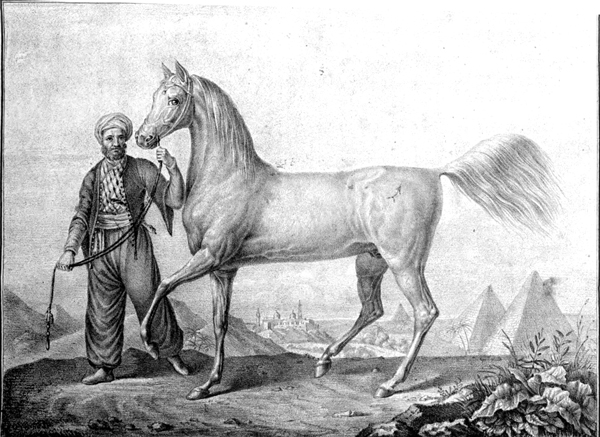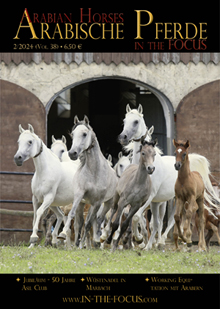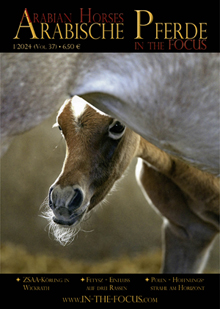The fleabitten grey Tajar (the Flying, the Fast in Arabic) was one of the most important Arabian stallions imported at the beginning of the 19th century to Hungary, for which reason the Hungarian Arabian Horse Breeders Association has chosen this stallion as its emblem.

The fleabitten grey Tajar (the Flying, the Fast in Arabic) was one of the most important Arabian stallions imported at the beginning of the 19th century to Hungary, for which reason the Hungarian Arabian Horse Breeders Association has chosen this stallion as its emblem.
Experts of the time unanimously agreed, that they “have never seen a more perfect and better conformed oriental horse… in which the national [i.e. Arabic] character of strength, vitality and volatility” was more pronounced. It was in 1811, when Baron von Fechtig imported this stallion from Cairo to Hungary. Originally, however, Tajar came “from the studs of pure breed of the then ruler Murad Bey, which was dissolved during the invasion of the French under Napoleon. He then came into the hands of Sheik Emir Bey, later became one of the personal mounts of Latife Basha and had the reputation from a long time ago, to be one of the most exquisite horses.” When the Egyptian viceroy Mohamed Ali heard that the Mamelukes wanted to rebel against him, he invited the most distinguished Egyptian Beys and Mamelukes insidiously on 1 March 1811 to come to the Citadel of Cairo, where he murdered 480 of them. “Their horses were for the most part a prey of Albanian soldiers, in which way also Tajar was taken to public sale. Here Baron von Fechtig came to see him and could easily buy him, regardless of his fine excellence, because at this time of terror only very few of the wealthy residents were seen in public.”
While crossing the Mediterranian from Alexandria to Trieste the ship ran into a storm. Since the former merchant ships were not designed for transporting horses, the horses were housed in makeshift sheds on top. Here, Tajar hurt himself considerably and had “a significant abrasion on the iliac bone (right), where now even a bald spot can be seen, he had moreover already in several engagements of war a spear in his throat, an injury in the neck and at one of his shins, where the traces still can be seen.”

Graf Hunyady sent his stud director von Appel to Trieste, to look at the horse. He recognized the value of the animal, although it looked very run down from the journey, and he paid the price of 1500 ducats – as it turned out, he was more than worth this price. Tajar became the most important stallion of the Ürmeny stud of Count József (I) Hunyady and left more than 200 offspring, which were characterized in particular by its speed. Röttger von Veltheim saw in him even a second Darley Arabian or Godolphin Arabian: “If you are watch Tajar from a distance standing or moving, you will become unsure, whether you see a real horse or a gazelle … there is something peculiarly easy, yes I would almost say ethereal, all over the shape and movement of this animal;… in short, this horse is a true racer of the desert of the noblest kind, there be no doubt, and if I would be the owner of a stud for breeding racehorses in England … I would believe that he will prove well with selected, large and bony English racing-mares in his offspring to be a second Godolphin or Darley Arabian.”
In Erdelyi we read: “The height of his body is 14 fist, 2 inches [152.5 cm Austrian tape measure], he is a fleabitten grey with blaze and two white socks on this hind feet… the age would be set to more or less 36 years …; he surpasses, however, despite his age, the volatility of most of the hungarian-bred horses. The Stud- and Stable-Inspector, Mr. Müller, who rode Tajar usually in the evening, noted that when he came to the heath before Ürmeny … he was, once left unleashed, hard to rein, and he often took him, as rider, his breath. When Tajar was moving, he was stretching in the movement and, as it appeared for the viewer, he grew in length and became one of the fastest four-legged creatures, similar to a gazelle, which sweeps through the air… Regardless of his age, and though he may have suffered on the front legs, he is still full of strength and fire and an able stallion who does not waste a covering. His offspring come after him, and show themselves just as excellent as their sire; He is distinguished moreover by the fact that even with not so very big mares, he has descendants of 15 Faust and 2 inches [162.5 cm tape measure] “.
Between 1814 and 1821 the first races of the Austrian-Hungarian Empire were held by Count Hunyady at his stud in Ürmeny, which attracted up to 40,000 spectators each year. “The first race was held on 22nd May 1814 for three-year-old fillies, who raced on a straight racecourse of one and a quarter mile, or 1082 1/2 “Wiener Klafter” with weights ranging from 70 – 90 pounds; they reached the winning post within three minutes”. Indeed, Tajars descendants frequently included the fastest. He was used as breeding stallion in the stud to Ürmény up to 1826 and produced 206 foals. From 1826 to 1830, he enjoyed his retirement. His skeleton is kept at the
Museum of k.k. Veterinary Institute in Vienna.
Gudrun Waiditschka












